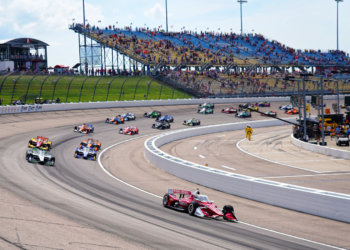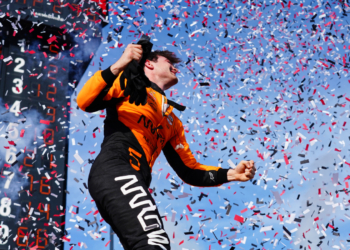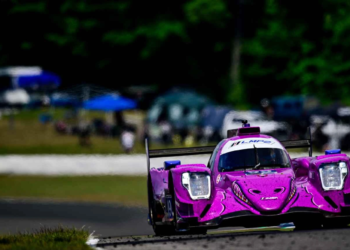In his latest exclusive column, former McLaren team member Marc Priestley takes a look at the invisible divide that exists within a team, something that was particularly noticeable during the 2007 season at McLaren.
When a team principal comes out after a race and announces to the world that “It was a great result for the whole team”, rarely is the statement 100% true.
No matter what the result, a significant portion of any F1 team will be disappointed that their car’s been less successful than the one sitting on the other side of the garage.
The reality of every team in pitlane is that there are actually three teams operating within each one.
Each car and driver have a crew of very dedicated people working solely and directly on that car and with that driver, who’s sole objective and goal is to bring that car home in the best position possible at each event.
In each team, there’s actually three ‘teams’.
The third group encompasses everyone else associated with the team. Support crew, truckies, management, strategists, catering staff, marketing and of course the hundreds of people back at each factory. These guys work to support the team in general and other than any personal preferences, have no direct affiliation to one side of the garage or the other. For them a win is a win, a point is a point, and a DNF from one car can be somewhat counteracted and offset by a decent result for the other.
When I entered Formula One many years ago after learning my trade throughout motorsport’s lower formulae, I was a little surprised at the concept of each car crew’s workload being strictly limited to that of their own car. I was used to working in smaller teams where, despite having dedicated mechanics for each car, everyone helped each other and when one was done, everyone moved across to get the other one finished before anyone went home.
The reason F1’s different is mainly due to the sheer size of the operation. Each car’s fully staffed and kitted out with everything they need to do the job and the truth is that most of the time help’s not needed, but even if it is, there’s not much room around the car to fit anyone else in. The other, and perhaps most relevant reason in this instance, is the close knit, competitive and protective car crew mentality which exists throughout the whole paddock. More often than not, unless absolutely necessary, ‘outside assistance’ isn’t particularly wanted.
Unlike most sports, the motor racing industry spawns this unique and fascinating dynamic through it’s position of pitting team mates against each other as direct competitors in the World Drivers Championship, whilst also operating as a single team unit in the World Constructors Championship during the same season.
The truth is an F1 driver and his entourage of trainers, managers, advisors, personal sponsors, guests, family and friends attending GP’s, have absolutely no interest whatsoever in what happens on the other side of the garage. For almost all of them, there is no team championship. Their vested interests, financial investments, professional success or simply associated kudos depends solely on the fortunes of one man and his race car, no more, no less. As a mechanic, engineer or other member of that driver’s car crew, although perhaps not always so extreme, a similar sense of camaraderie normally builds amongst the guys as they put heart and soul into giving their guy the best shot at every race. For these guys in a leading team, a 1-2 finish is only a really great result if their car is first.
Of course there’s generally no real animosity between mechanics etc. Any feelings of disappointment or bitterness when the other car does better than yours are kept well hidden. There’s always congratulatory handshakes and the corporate smiles come out convincingly on demand for the cameras. With racing drivers, however, over inflated egos and uncontrollable self centeredness can often make it a little easier to tell if they really are happy for the team result, or thinking no further than their own disappointment.
I’ve been involved in F1 for a long time now and been a fan for even longer, not since the days of Prost and Senna has there been a more bitterly contested rivalry within a team than at McLaren in 2007.
I’d taken up a new, more central role that year, overseeing the build of both race cars and therefore formed part of that third team of people within the organisation I spoke of earlier. Both Lewis and Fernando were new to the team and I had no particular allegiance to either as the season began. Both drivers got on well together, Fernando confident of his unspoken number one position and Lewis, at that stage, in awe of his team-mate and keen to learn from him.
By the time we reached Monaco, Lewis’ confidence had boomed, perhaps a little too much it could be said for someone with an F1 career consisting of four races. Fernando, I’m sure, was finding it a little ‘frustrating’ that the new boy wouldn’t just stay behind him and when it came to that race and both cars were fast and out in front, radio traffic became a little heated from both drivers. Lewis was told to hold his second position to avoid risking a crash around the tight and unforgiving streets of Monte Carlo, but proceeded to push Fernando all the way, attempting numerous bold moves. Both were shouting and screaming over the radio and it became the beginning of the end of the partnership, but significantly the beginning of a huge split down the middle of the McLaren garage.
The drivers are hugely influential forces in any F1 setup, it’s a responsibility that comes with the job. If the driver pairing works, together they can galvanise a team, boost moral and help drive everyone on, what happened in 2007 at McLaren was quite the opposite.
As the drivers began to publicly fall out, and particularly after the well documented Hungary qualifying incident, there was no secret that the two didn’t like each other and the last thing they would be prepared to do would be to work together.
The unavoidable tension didn’t take long to spread throughout the team. Fernando tried desperately to rally his own side of the garage with ‘perks’ for people associated with his car and Lewis played his best media games, notably a display of shaking hands with the entire team whenever the TV cameras came in pre-race.
The car crews, as ever got behind their men, but interestingly developed a quite intense distain for the driver on the other side of the invisible divide. A rivalry like I hadn’t really seen before emerged between mechanics and engineers on either side and even they began to distance themselves from each other more and more.
With all this going on each week, coupled with our exclusion from the constructors’ championship as part of the Spygate affair, McLaren was not a nice place to be working that year. As someone with no affiliation to either driver, I lost a lot of respect for both during the course of the season.
They were both incredibly fast and we had a very fast car. It was a year when our team should have cleaned up and yet the shameful truth is that when we got to Brazil, with both of them in contention for the WDC, but no WCC points to play for, in my heart I hoped Kimi would come away victorious.
Of course I still did the best job I could over the weekend and in pitstops etc, but to have those feelings shocked me and was a dramatic example of the influence of two bickering drivers within the same team over everyone else within it.
F1’s a team sport and whilst healthy competition on the inside is great, it needs everyone within pulling in the same direction to be successful. One portion of the team is always likely to end up happier than the other, but at the end of the day, if the figureheads, the public faces of that team, are pulling each other apart, they pull the whole lot down with them very quickly.
When you hear a team principal come out after a race to announce to the world that “It was a great result for the whole team”, it may not be strictly 100% true, but they’re saying it for a very good reason.






